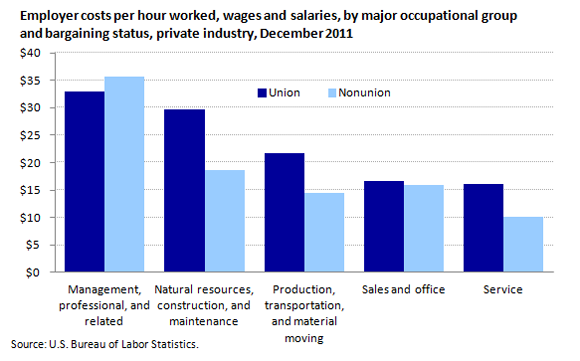An official website of the United States government
 United States Department of Labor
United States Department of Labor
In December 2011, private industry union workers earned more per hour than their nonunion counterparts in all major occupational groups except management, professional, and related occupations.

| Occupational group | Union | Nonunion |
|---|---|---|
All workers | $23.04 | $19.84 |
Management, professional, and related | $32.95 | $35.70 |
Natural resources, construction, and maintenance | $29.69 | $18.71 |
Production, transportation, and material moving | $21.78 | $14.40 |
Sales and office | $16.60 | $15.98 |
Service | $16.17 | $10.16 |
Union workers in natural resources, construction, and maintenance occupations earned $29.69 per hour, while nonunion workers in that occupational group earned $18.71 per hour. Unionized workers in production, transportation, and material moving occupations earned $21.78 per hour, compared with $14.40 per hour for nonunion workers. Unionized sales and office workers earned $16.60 per hour, compared with $15.98 for nonunionized sales and office workers. In service occupations, union workers earned $16.17 per hour compared with $10.16 for nonunion workers.
In management, professional, and related occupations, union workers earned less per hour ($32.95) than nonunion workers in these occupations ($35.70). The wage advantage for nonunion workers in this group reflects the concentration of union workers in certain relatively low-paying occupations in business and financial operations, such as claims adjusters, accountants, and training specialists
These data are from the National Compensation Survey program. Union workers are those represented by a labor organization in collective bargaining. To learn more, see "Differences in union and nonunion compensation, 2001–2011," (HTML) (PDF) by George I. Long, Monthly Labor Review, April 2013.
Bureau of Labor Statistics, U.S. Department of Labor, The Economics Daily, Union and nonunion wages, December 2011 at https://www.bls.gov/opub/ted/2013/ted_20130513.htm (visited January 07, 2026).

